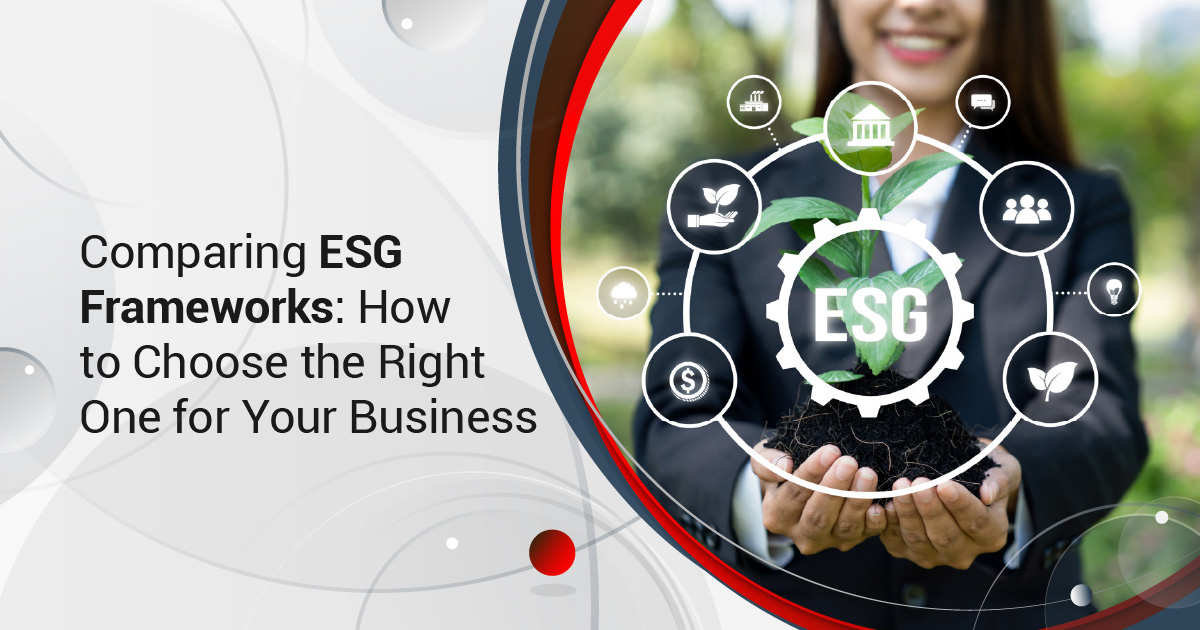Your next loan application, insurance renewal, or major client tender will likely include ESG questions you cannot currently answer. Singapore business leaders who dismiss sustainability reporting as simple paperwork are discovering their oversight costs real money – in higher borrowing rates, lost contracts, and missed investment opportunities.
The regulatory clock started ticking months ago. The Singapore Exchange now requires Scope 1 and Scope 2 climate-related reporting for all listed companies from FY2025, while MAS guidelines force banks to evaluate environmental risks in every lending decision. Your unlisted SME faces the same scrutiny from your financial partners.
Several frameworks dominate the reporting space, each with different data, serving different audiences, and requiring different resources. Pick the wrong combination and you will likely spend months collecting irrelevant metrics while missing what actually matters to your stakeholders.
The framework you select shapes your reporting burden and your entire ESG strategy and its business outcomes. This article provides the practical framework selection guidance you need to make informed decisions that serve both compliance requirements and business strategy.
Key Takeaways
- Ignoring sustainability reporting can lead to higher borrowing costs, lost contracts, and missed investment opportunities.
- ESG reporting frameworks have consolidated into two main standards, ISSB and GRI.
- SGX mandates ISSB compliance from FY2025, while GRI remains voluntary but widely adopted.
- Poor framework selection can lead to wasted resources and compliance issues.
Singapore’s ESG Reporting Requirements Have Already Changed

The voluntary era ended quietly. SGX mandated climate-related disclosures for financial, agriculture, food, forest, and energy sectors starting FY2023, expanding to materials, buildings, and transportation companies from FY2024. The “comply or explain” safety net disappeared for these industries.
Crucially, your company’s size will not protect you much longer, despite the updated delays in mandatory climate disclosure requirements:
| Listed Companies (ListCos) | |||
|---|---|---|---|
| Mandatory Requirements | Straits Times Index (STI) Constituents | Non-STI Constituent Listed Companies With at Least S$1 Billion Market Cap | Non-STI Constituent Listed Companies With Less Than S$1 Billion Market Cap |
| Scope 1 and 2 GHG Emissions | FY2025 | ||
| Other ISSB-based Climate Reporting Disclosures | FY2025 | FY2028 | FY2030 |
| Scope 3 GHG Emissions | FY2026 | Voluntary | Voluntary |
| External Limited Assurance for Scope 1 and 2 GHG Emissions | FY2027 | FY2029 | |
| Large Non-Listed Companies (NLCos) | |||
|---|---|---|---|
| Mandatory Requirements | NLCos (Annual Revenue of at Least S$1 Billion and Total Assets of at Least S$500 Million) | ||
| Scope 1 and 2 GHG Emissions | FY2030 | ||
| Other ISSB-based Climate | |||
| Reporting Disclosures | |||
| Scope 3 GHG Emissions | Voluntary | ||
| External Limited Assurance for Scope 1 and 2 GHG Emissions | FY2032 | ||
Singapore businesses are, however, responding rapidly to these changes. KPMG Research shows 76% of Singapore’s top 100 companies now formally recognise climate change as a financial risk, jumping from just 49% in 2022. This shift reflects both regulatory pressure and genuine business understanding of climate-related financial impacts.
As is typical of Singapore, the government backs this transition with genuine investment. Singapore’s Green Plan 2030 includes up to S$35 billion in green bonds by 2030 to build market infrastructure. MAS and SGX launched the ESGenome digital portal to simplify reporting for listed companies, providing automated mapping across multiple frameworks.
Your competitors are already positioning themselves in this new environment. The question is not whether ESG reporting will affect your business – it is whether you will be ready when it does.
The Framework Convergence: From Six to Two
The ESG reporting world simplified dramatically over the past three years through a series of strategic mergers that most business leaders missed. What used to be six competing standards is now essentially two choices, each serving different business needs.
SASB, IIRC, and CDSB all merged into the IFRS Foundation between 2021 and 2022 to create the International Sustainability Standards Board (ISSB). The Task Force on Climate-related Financial Disclosures (TCFD) disbanded in October 2023, handing over its climate reporting architecture to the same ISSB. Four frameworks became one investor-focused standard.
The remaining landscape splits cleanly:
- ISSB standards target investors and focus on financial materiality – how ESG issues affect your company’s performance.
- GRI targets broader stakeholder groups and focuses on impact materiality – how your company affects society and the environment.
As mentioned earlier, SGX requires IFRS S1 and S2 standards from FY2025, making ISSB compliance mandatory for listed companies. GRI remains voluntary (although officially recommended) but maintains its 99.1% adoption rate among SGX companies because it addresses stakeholder needs that ISSB doesn’t cover.
Framework Comparison for Business Leaders
ISSB Standards (Mandatory from FY2025) target investors and lenders who need to understand climate and sustainability risks in your business. Focus on financial materiality – metrics that affect your cash flow, borrowing costs, and enterprise value. Required for SGX compliance.
GRI Standards (Voluntary but Widespread) target employees, customers, communities, and regulators who want to know your impact on society and the environment. Used by the overwhelming majority of SGX companies because stakeholders demand this information even when regulators don’t.
CDP Platform (Industry-Specific) environmental scoring system that major suppliers and investors use for procurement and investment decisions. Focuses on climate, water, and forest impacts with letter grades from A to D-.
SASB Industry Standards (Now Part of ISSB) provides specific metrics for 77 different industries – software companies report on data security, while mining companies report on water management and ecological impacts.
Singapore’s market leaders combine approaches strategically. For example, CDL uses a “two-pillar” model with value reporting for investors and Impact reporting for stakeholders. ComfortDelGro, on the other hand, adopts GRI, SASB, and ISSB simultaneously to serve multiple audiences through one report.
The smartest approach matches your framework selection to your actual stakeholder priorities, not theoretical best practices.
Strategic Decision Framework

Step 1: Identify Your Primary Audience List who actually reads your sustainability information. Banks reviewing loan applications need ISSB financial metrics. Employees considering job offers want GRI social impact data. Major customers conducting supplier audits often require CDP environmental scores. Your framework choice should match your most critical relationships.
Step 2: Run a Double Materiality Assessment SGX requires documented materiality assessment showing which ESG topics affect your business. Map issues on two axes: financial impact (affects your performance) and impact materiality (your effect on society). High-scoring items in both categories demand comprehensive reporting.
Step 3: Study Local Success Models OCBC combines GRI, SASB, TCFD, and IFRS S1/S2 in their 2024 report to serve diverse stakeholder needs. CDL’s Value and Impact pillar approach separates investor-focused metrics from broader stakeholder communication.
Our advice to most Singapore companies with complex stakeholder bases is to leverage the benefits of ISSB, combined with GRI. Start with mandatory ISSB compliance, then add GRI sections addressing your specific stakeholder priorities.
Practical ESP Framework Implementation Recommendations

SGX requires board-level oversight for sustainability reporting, so your directors need regular ESG performance updates, not just annual report approval. Centralised data systems prevent the common problem of different departments providing conflicting numbers.
Start with your mandatory requirements first. ISSB compliance protects your regulatory position and investor relationships. Add GRI reporting for specific stakeholder needs – employee retention, customer loyalty, community relations. Include CDP if major clients or suppliers demand environmental scores.
Government support makes implementation cheaper than most companies expect. The Enterprise Sustainability Programme offers up to S$180 million in funding for local companies building sustainability capabilities.
Your framework choice shapes your entire ESG strategy. Companies that treat reporting as compliance paperwork miss the competitive advantages that come from systematic sustainability management. Done properly, ESG reporting becomes the foundation for operational improvements, cost reductions, and stakeholder trust that drive long-term business value. If in any doubt whatsoever, we encourage you to reach out to a trusted, local ESG partner such as InCorp for bespoke advice.
Where to Next With InCorp
Singapore’s ESG reporting requirements will only get stricter. The companies that position themselves correctly now will benefit from improved access to capital, stronger stakeholder relationships, and operational efficiencies that directly impact their bottom line.
The wrong framework choice costs time and money. InCorp’s specialists understand SGX compliance requirements, stakeholder expectations, and the practical challenges of data collection and reporting. Our team guides you through materiality assessments, framework advisory, and implementation planning that matches your business objectives.
Let ESG reporting become a strategic advantage, not a compliance burden. Contact InCorp today to discuss your ESG framework strategy and ensure your sustainability reporting serves your business goals effectively.
FAQs about ESG Frameworks
Which ESG framework is mandatory for Singapore companies?
- SGX-listed companies must use IFRS S1 and S2 standards from FY2025 for sustainability reporting. GRI remains voluntary but is used by 99.8% of SGX companies.
Should my Singapore business use GRI or ISSB standards?
- Most Singapore businesses benefit from combining both frameworks. ISSB standards meet regulatory requirements and serve investor needs, while GRI addresses broader stakeholder expectations. Your choice depends on your primary audience and compliance obligations.
What happens if my company does not comply with ESG reporting requirements?
- Non-compliance with SGX mandates can result in regulatory action, public censure, or delisting risks for listed companies. All companies face reputational damage and potential impacts on access to capital, insurance rates, and major client relationships.


